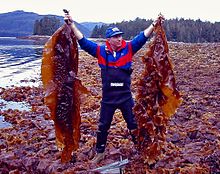Sugar kelp
| Sugar kelp | ||||||||||||
|---|---|---|---|---|---|---|---|---|---|---|---|---|

Sugar kelp near Helgoland |
||||||||||||
| Systematics | ||||||||||||
|
||||||||||||
| Scientific name | ||||||||||||
| Saccharina latissima | ||||||||||||
| ( L. ) CELane , C.Mayes , LDDruehl & GWSaunders |
The sugar kelp ( Saccharina latissima , syn .: Laminaria saccharina ) is a type of brown algae from the order of the Laminariales .
description
The seaweed is attached to a solid substrate with a strong claw-like adhesive organ ( rhizoid ). The leaf-like, yellow-brown phylloid sits on a thin, relatively short stem ( cauloid ) . This is band-shaped and strongly corrugated at the edge. The entire thallus can be 2 to 4 meters long.
Occurrence
The distribution area of the sugar kelp includes the rocky sea coasts of the cool, temperate zones of Europe, Asia and America (circumboreal distribution). In Europe it occurs from the North Atlantic to the Baltic Sea and the western Mediterranean . Together with Laminaria species, it forms kelp forests in the sublittoral below the low water line. In Helgoland , the sugar kelp grows at a depth of 0 to about 10 meters below sea chart zero . In the western Baltic Sea it occurs in water depths of up to 20 m. In recent years, a decline in this important species of brown algae has been observed on the European coasts. The reasons for this are mainly suspected to be over-fertilization (eutrophication).
Systematics
The first description of the sugar kelp was in 1753 by Carl von Linné under the name Ulva latissima L. Jean Vincent Félix Lamouroux placed it in the genus Laminaria as Laminaria saccharina (L.) JV Lamouroux in 1813 , in the literature it is still largely carried under this name. The sugar kelp was placed in the genus Saccharina by Christopher E. Lane , Charlene Mayes , Louis D. Druehl and Gary W. Saunders in 2006, along with a number of other species (including all used for kombu ) . John Stackhouse had classified it in this genus as early as 1809 as the two species S. plana and S. bullata .
use
The sugar kelp is edible. It contains sugars that make it taste slightly sweet. For example, you can wrap short pieces of the leaf-like part (phylloid) around a piece of camembert and then bake these rolls in the pan. It is harvested on a small scale in Ireland for kombu . The sugar kelp is considered a healthy food because it has a high protein content of up to 15% and a low fat content of less than 5%. A regional form in the North Pacific is eaten in Japan as Karafuto-kombu (" Sakhalin -Kombu").
Henkel claims to use the sugar algae in shampoos. The sugar algae is marketed as "Anti-Ox Alge" under the Schwarzkopf brand and is allegedly grown on the German Baltic coast.
swell
- P. Kornmann, PH Sahling: Sea algae from Helgoland - Benthic green, brown and red algae. Biological Institute Helgoland, Hamburg 1983, ISSN 0017-9957 , pp. 144-149. (Sections Description, Occurrence)
- Michael D. Guiry, GM Guiry: Saccharina latissima In: Algaebase - World-wide electronic publication, National University of Ireland, Galway , accessed March 9, 2012 (section systematics)
- Michael Guiry: The Seaweed Site: information on marine algae: Saccharina latissima , accessed March 9, 2012 (Sections Occurrence, Use)
- Trine Bekkby, Frithjof E. Moy: Developing spatial models of sugar kelp (Saccharina latissima) potential distribution under natural conditions and areas of its disappearance in Skagerrak. In: Estuarine, Coastal and Shelf Science 95/4: 477-483. doi: 10.1016 / j.ecss.2011.10.029
Individual evidence
- ↑ Agnes Mols-Mortensen, Elma á Geilini Ortind, Charlotte Jacobsen, Susan Løvstad Holdt: Variation in growth, yield and protein concentration in Saccharina latissima (Laminariales, Phaeophyceae) cultivated with different wave and current exposures in the Faroe Islands . In: Journal of Applied Phycology . tape 29 , no. 5 , October 1, 2017, ISSN 1573-5176 , p. 2277-2286 , doi : 10.1007 / s10811-017-1169-4 .
- ↑ Gonçalo S. Marinho, Susan L. Holdt, Charlotte Jacobsen, Irini Angelidaki: Lipids and Composition of Fatty Acids of Saccharina latissima Cultivated Year-Round in Integrated Multi-Trophic Aquaculture . In: Marine Drugs . tape 13 , no. 7 , July 15, 2015, ISSN 1660-3397 , p. 4357-4374 , doi : 10.3390 / md13074357 , PMID 26184241 , PMC 4515622 (free full text).
- ↑ http://www.schwarzkopf.de/de/marken/haarpflege/beology/einzigartige-formel.html

